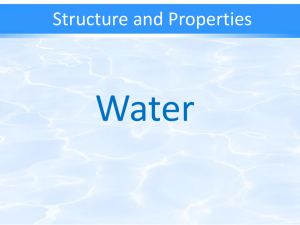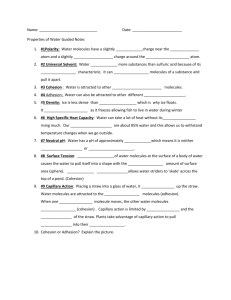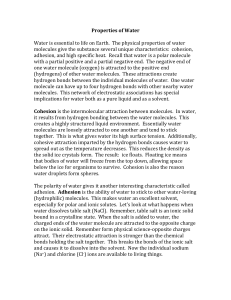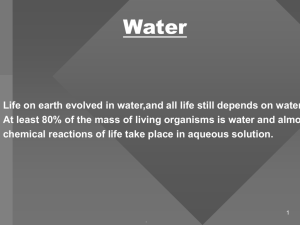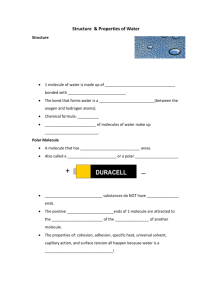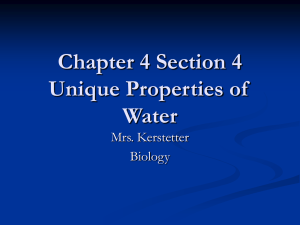Properties of Water Powerpoint
advertisement
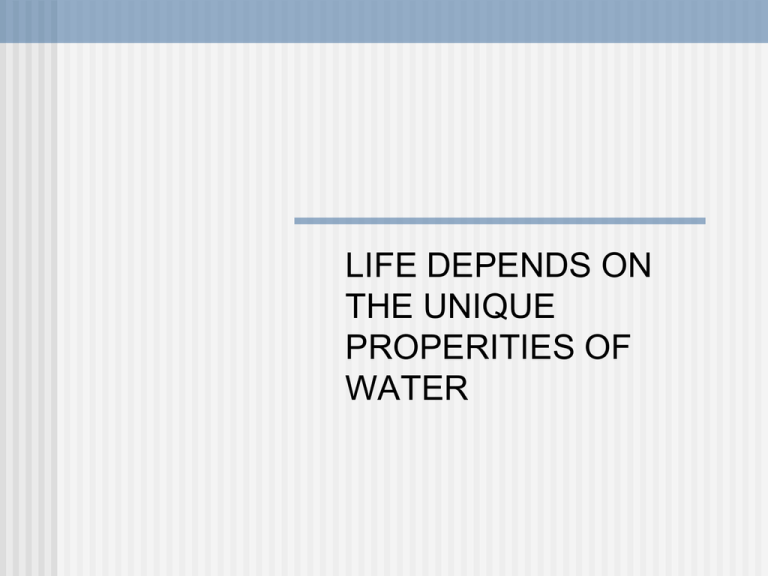
LIFE DEPENDS ON THE UNIQUE PROPERITIES OF WATER Physical Properties- can be observed and measured Water is a form of matter Matter- anything that occupies space and has mass What happens when you put an ice cube in a glass of water? Why???? What do you think would happen to a can of coke and diet coke if we placed it into a container of water? Float? Sink? Why? THE STRUCTURE OF WATER Made up of two covalently bonded hydrogen atoms to an oxygen atom Polar Molecule- a molecule that has opposite ends with opposite charges THE STRUCTURE OF WATER Hydrogen Bondweak attraction, bond between a hydrogen atom of a molecule and a slightly negative atom within another molecule. WATER’S LIFE SUPPORTING PROPERTIES Cohesion Adhesion Temperature Moderation Low Density of Ice Water’s Ability to Dissolve Other Substances COHESION AND ADHESION Cohesion- the tendency of molecules of the same kind to stick to one another Adhesion- an attraction between unlike molecules COHESION AND ADHESION Example: water transport of trees/plants Evaporation pulls water which are attached by cohesion up from the roots. Adhesion of water to the walls of veins resist the downward pull of gravity Drops On a Penny How many drops fit on the penny? Explain the bubble that forms on penny COHESION AND ADHESION Surface Tensioncohesion which pulls the molecules at the surface tightly together When have you experienced surface tension? http://www.youtube .com/watch?v=6eh 93mut9K4&feature =relmfu Basilisk Lizard http://www.youtube.com/watch?v =45yabrnryXk&feature=fvw http://www.teachertube.com/view Video.php?video_id=96527 TEMPERATURE MODERATION Thermal Energy- total amount of energy associated with the random movement of atoms and molecules in a sample of matter. Temperature- a measure of energy of random motion of particles in a substance TEMPERATURE MODERATION When two substances differ in temperature, thermal energy in the form of heat is transferred from the warmer substance to the cooler one TEMPERATURE MODERATION When you heat molecules move faster When you cool molecules move slower Water takes more energy to heat because of hydrogen bonds Water retain heat longer because of hydrogen bonds LOW DENSITY OF ICE Density- amount of matter in a given volume In most substances the solid state is more dense than the liquid state LOW DENSITY OF ICE Water’s solid state is LESS dense than the liquid state WHY????? Hydrogen bonds in ice (solid) keep molecules spaced out LOW DENSITY OF ICE Since ice is less dense than water it floats Ice prevents oceans from freezing over Ice insulates the liquid water below allowing life to persist WATER’S ABILITY TO DISSOLVE OTHER SUBSTANCES Solution- a uniform mixture of two or more substances Solvent- the substance that dissolves the other substance and is present in greater amounts (water) Solute- the substance that is dissolved, present in a lesser amount (salt) WATER’S ABILITY TO DISSOLVE OTHER SUBSTANCES Aqueous Solutionwhen water is the solvent Water molecules surround ions and break them apart WATER’S ABILITY TO DISSOLVE OTHER SUBSTANCES Water is the “Universal Solvent” Water is the main solvent inside all cells, blood, and plant sap Wrap Up! http://www.youtube.com/watch?v=QH1yphfgfFI Structure of Water Molecule = Bent. Why? 5 Unique Properties of Water: 1. Cohesion 2. Adhesion 3. Temperature Moderation 4. Low Density of Ice 5. Water’s Ability to Dissolve other Substances Exit Slip 1. Explain how the structure of water molecules results in attractions among them. 2. Give an example of how cohesion among water molecules is important to living things. 3. Explain one way in which water can moderate temperature.
